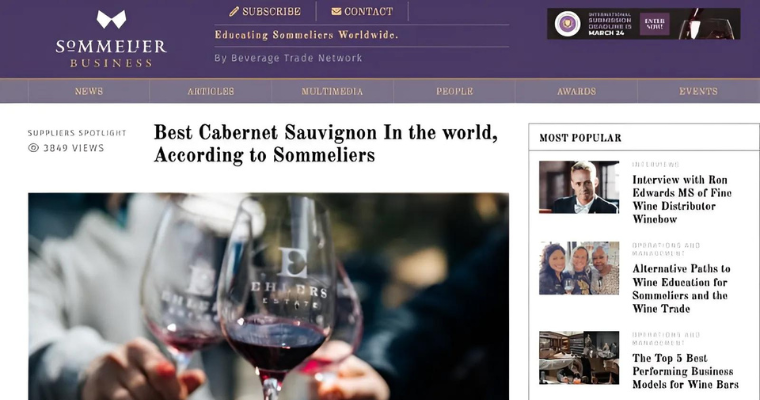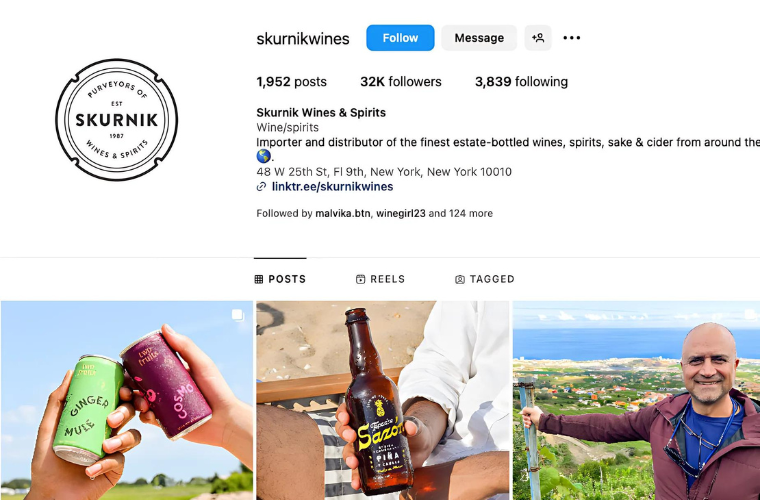Early Bird
Deadline
January 31, 2026
Judging
Date
May 18, 2026
Winners
Announced
June 10, 2026

Getting your brand ready for business in the USA requires a thorough understanding of what US importers are looking for and how to service their needs. In the US, foreign brands cannot legally sell their wines or spirits directly to distributors or retailers. They must first appoint an importer who will have exclusive rights to the brand in their territory. The importer will then work with their distribution partners who will in turn supply their retail partners with the imported brand. This system, called the Three Tier System, creates a very complex and competitive marketplace.
In order to ensure they are working with brands that they think will successfully penetrate the US system, importers look to source new products that come with solid marketing budgets, premium packaging, good price points, and exceptional taste. Depending on the importer profile, the preferences given to these characteristics can vary drastically. It is important to target importers who work with similar brands to yours and understand what it means to be a part of a successful stateside brand launch. As the importer contract gives the importer exclusive rights to your brand, you want to protect yourself against potentially signing on to an ill-suited import partner.
Tip: You should know well how retailers and restaurants buy so you understand the needs of your distributors and importers of USA. Here is one great video on how you can build your beverage brand in the on-trade of the USA market.
After doing your due diligence researching importers who you think will be good fits for your business goals, it’s time to find innovative ways to get importers interested in your brand and ready to develop a working partnership. You can learn in the upcoming webinar on how to find wine importers in the USA and effectively pitch them.
1. I am willing to support the distributor with time, money, and product to generate sales.
2. I have identified my brand and listed its competitive advantages.
3. I have a marketing strategy that is being actioned.
4. I understand that the first purchase order is simply a start and I have to do the work of selling.
5. I understand my brand must sell through at distributor’s customer (The retailer).
6. I understand that it is a partnership and the distributor needs to make money.
7. I understand distributors’ logistics and the pick-up location they use normally for other suppliers.
8. I understand their bookkeeping, invoice, PO process, reporting, and key personal map.
9. I understand I need to be a likable supplier.
10. I understand I have to get new accounts for my distributor.
11. I understand I have to get floor displays for my distributor.
12. I understand I have to get national accounts and pass on that business to my distributors’
territory.
13. I understand keeping in the loop the distributor's C-suite about all the communications I am
having with their sales reps and accounts.
14. I understand my payments will affect my brand's sales performance.
15. I understand I have to be consistent with my pricing and supply.
At all levels, markup is added. Learn how you need to price your wine and spirits brands before you pitch your brands to a prospective importer.

The three-tier system of alcohol distribution is the system for distributing alcoholic beverages set up in the United States after the repeal of Prohibition. The three tiers are producers, distributors, and retailers. The basic structure of the system is that producers can sell their products only to wholesale distributors who then sell to retailers, and only retailers may sell to consumers. Producers include brewers, wine makers, distillers, and importers At all levels markup is added. But the good news is import taxes are much lower than in many parts of the world and thus you see the US as one of the biggest wine markets in the world. The American three-tier distribution system is governed by the 21st Amendment of the United States Constitution. When the U.S. Congress first passed this law in 1933, this historic Constitutional Amendment overturned the infamous 18th Amendment to the U.S. Constitution, passed 14 years before in 1919.
At the state level, two legal approaches are taken. 32 states allow the private sector to distribute and sell alcoholic beverages, including such states as California, New York, and Florida, among others via the three-tier wine distribution system. Elsewhere, 18 states have decided to adopt a so-called control distribution model, under which the state is involved in one or more tiers of the traditional three-tier distribution system noted earlier. Here is one great video on how a wine wholesaler operates.
Once you have understood the pricing and the USA three-tier system, it's time to find a wine importer. You can learn more about the Three-tier system, Controlled States, and TTB in the USA here.
1. Working From The Retail Shelf Back to the Importer
Even though you cannot directly sell your product to retailers in the three-tier system, it is highly recommended that imported brands develop strong ties to retail buyers and build a solid consumer base of excited customers who want to see the brand in their territory. By initiating market demand before approaching importers in the region, chances are the importer will already know about your product and be happy for the opportunity to work with you towards a successful brand launch. Here is one great article on how to pitch to a wine retail buyer.
2. Targeted Emails
Developing a professional PowerPoint presentation is more than just getting ready for your sales pitch. You can use a well-thought-out presentation in your personalized emails to importers that highlight your brand and show them that you are ready to do business. The more detailed the information you provide that clearly delineates a market strategy, the easier it will be for them to see the benefits of taking your brand on. Check tips on how to build your winery sales process to grow distribution as well.
3. Trade Shows
Another way to elicit demand for your product at every tier of the distribution chain is to successfully exhibit your brand at important industry trade shows. Getting your brand in front of buyers, media, and market makers is an important first step in showing the US industry that you are here to stay. Use specialized trade shows to build your network base and develop long-lasting relationships that you can leverage when talking with potential importers. If you are looking for an importer, we highly recommend USA Trade Tasting which aims to be the leading specialist wine, beer, and spirits trade show to help you connect with importers and distributors of the USA.
4. Local Organizations
There are many national and regional groups that can help you develop your message for international partners. Make sure you utilize all of your local organization’s networks by using the support programs they offer to get your message out to international trade. One of the best ways to generate interest from importers is to have second-party recommendations from important market influencers and often this means working closely with those organizations that already have an established sales network.
5. Ratings and Reviews
Submitting your products into competitions and getting highlighted in influential publications can increase your brand recognition and generate interest from representatives across all tiers of the industry. Increasing your portfolio of ratings and reviews from substantiated sources is practically a pre-requisite to successful brand launches in today’s saturated market. The assumed belief by retailers and distributors is that is much easier to sell a new product with lots of awards, points, and feature articles associated with the brand to US customers than it would be otherwise. Make sure you have allotted a good marketing budget to fulfilling this goal as the same philosophy often translates itself up the supply chain and manifests itself in the initial decision-making process of importers.
You can support your wine importers or even potential wine importers by sending them samples or asking them to submit to the leading wine competitions in the USA.

Sommeliers Choice Awards is a great wine competition that helps wine importers position their wines to the on-trade channels of the USA. With the backup of BTN and SommelierBusiness.com, wine importers are able to penetrate the on-premise channel of the USA.
6. Social Media and LinkedIn

Image Source: Instagram
Use LinkedIn or Instagram to search for wine importers in the USA. A well-structured LinkedIn profile can help make valuable connections. Additionally, joining wine-related groups and participating in discussions can increase visibility among importers. Follow them, engage with them, and then DM them. Get noticed by them.
1. Understand Their Portfolio: Research the importer’s existing portfolio to understand what type of wines they carry and identify any gaps your wines could fill. Tailor your pitch to show how your wine complements their collection without directly competing with it. Register for the webinar to get insights on how to effectively pitch to a wine importer.
2. Prepare Your Pitch Materials: Develop clear, concise, and professional sales materials, including a compelling brand story, detailed product specifications, unique selling points, and any critical acclaim or awards your wines have received.
3. Offer Competitive Pricing and Terms: Understand the pricing structure within the U.S. market and offer competitive terms that can entice importers to take a chance on your brand. Be transparent about your suggested retail prices and any support you can offer in promotions or marketing.
4. Sample Products: Nothing sells wine quite like the wine itself. If possible, provide sample bottles along with detailed tasting notes and food pairing suggestions. This can help the importer assess the quality and marketability of your wine. Here are some detailed tips by Sid Patel, our CEO on how to send your samples to importers and distributors effectively and improve conversion.
5. Follow-Up: After your initial contact and sending any samples, follow up with a polite and professional email or phone call. Persistence is key, but always maintain a balance—be persistent without becoming pushy.
6. Demonstrate Market Knowledge: Show that you understand the U.S. wine market by discussing trends, consumer preferences, and successful case studies relevant to your wine. This shows potential partners that you are serious and proactive.
7. Build a Relationship: Even if the initial pitch doesn’t result in an agreement, maintain the relationship. Markets and needs can change; keeping in touch keeps your brand top of mind.
[[relatedPurchasesItems-61]]
Successfully pitching to U.S. wine importers involves a combination of thorough market research, professional persistence, and a clear demonstration of how your wine meets the needs of both the importer and their customers. By carefully targeting the right partners and crafting a compelling pitch, you can increase your chances of gaining a fruitful foothold in the competitive U.S. wine market.
If you are an overseas winery looking to find a wine importer in the USA, we encourage you to attend this free webinar on ‘How to find wine importers in the USA and pitch them effectively’ on December 10, 2024.
In this talk, Sid Patel, CEO of Beverage Trade Network, USA Trade Tasting, and Sommeliers Choice Awards will moderate the call with leading wine importers of the USA on how wineries should approach wine importers in the USA and make an effective pitch. There will be a short presentation by Sid followed by Q and A from wineries with an importers panel.
Once you RSVP here we will send the Zoom link to your email.
Header Image Source: Skurnik Wines & Spirits
Enter your Wines now and get in front of top Sommeliers, Wine Directors, and On-Premise Wine Buyers of USA.
